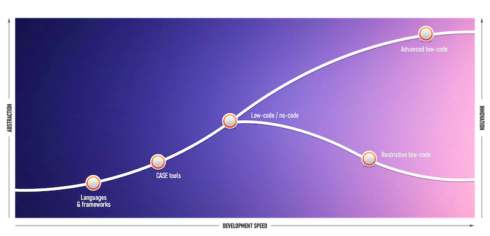
Can you scale an entire enterprise software architecture with zero code? Probably not. Can a low-code platform singlehandedly create and expose compelling infrastructure? Maybe. Can the new generation of low-code tools conquer their predecessor’s limitations to deliver fast, efficient and extendable technology for the modern business?
RELATED CONTENT: 2021: The year of low code
Enterprise low-code platforms provide a more robust and disciplined method to application development than earlier versions of low-code by providing the capabilities to build enterprise software, not just simple apps.
The modern CIO: Pace beats framework
As technology becomes increasingly important, an organization’s success depends on whether the CIO can balance the demands of managing traditional IT operations and driving strategic initiatives, with transformational change high on the list. To do so, the modern CIO is on the road to digital disruption and is on the lookout to automate manual and repetitive business processes to save time and improve efficiencies. They are increasingly turning to tools designed to create applications quickly, without the sweat of writing and debugging lines of code. In a world where everything has to happen faster, low-code and no-code platforms are now viewed as essential tools to gain a competitive advantage for developers and the organisations employing them.
Trapped by design?
But they worry too. They worry because, despite the apparent benefits of faster development, there have been several issues across the industry that have continuously frustrated and tormented users over the years. The biggest of these – and in any application development environment, no matter the technology – is the dreaded “ty’s” – complexity and extensibility.
They worry that they will move fast at first but encounter platform limitations later in the development process that will prevent them from extending their applications. They worry about how best to integrate with the myriad of systems and databases that exist in their environment. They fear that applications built with no-code tools are usually challenging to customize and have no unique functionality—which can be troublesome if you need to address challenges. They worry about vendor lock-ins. About architectural considerations. About hosting. They worry about the platform’s capability beyond the necessary efficiency of delivering a simple departmental app. Sound familiar?
The new generation of low code
That was then. The now is a new generation of application development platforms emerging that don’t quite fit the boundaries of ‘traditional’ low-code development. These tools are more mature, more robust and quickly address and eliminate the valid concerns of the first-generation tools. They are focused on delivering faster solutions, greater granular control and a myriad of newer features for the modern IT environment. They are concentrated on providing a platform for skilled developers (not citizens!) to work smarter and quicker. They still eliminate repetitive coding, but additionally offer the ability to implement customization unique to the business, from design, through to development and architecture.
Being a professional software developer today is not about writing within a programming language, and writing code is not the most crucial part of the job. Software development is mostly about the stack, the platforms, data sources, databases, network layers, APIs, security mechanisms and procedures that you use to build software solutions.
These new low-code platforms offer a modern software experience that aligns with today’s changing user demands. They provide scalable architectures, the ability to extend platform capabilities with open APIs for reusability, and more flexibility when it comes to cloud and on-premises deployment. They enable developers to exercise control with application testing, quality and performance tooling while incorporating the high productivity techniques seen in low-code solutions to speed development through visual means.
They are also ideal for highly scalable applications that support complex logic—the kind of custom applications that support digital transformation of your business. The requirements may have changed – you do need IT knowledge to gain the benefits – but it has made it easier to build robust, unique, and intricate applications more quickly than with conventional development tools.
In this way, the new generation of low-code tools are dramatically abstracted from standard software development. Vendors such as Siemen’s Mendix, Amazon’s Honeycode, Google’s AppSheet, Microsoft’s Power App and independent players such as Linx and OutSystems, will reduce cycle times and improve agility by delivering applications at the pace of business.






